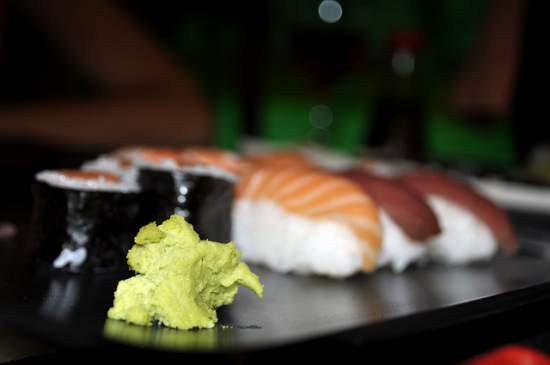
Restaurants serve wasabi with sushi. This delicious herb is hard to find, so hotels outside Japan use horseradish, mustard and food colors. These ingredients may triggers wasabi allergy symptoms in hypersensitive people. (1)
outside Japan use horseradish, mustard and food colors. These ingredients may triggers wasabi allergy symptoms in hypersensitive people. (1)
Food colors and chemical preservatives used in food preparation aren’t healthy for your body. They often irritate immune system, which then releases IgE antibodies to detect them. Next time when you ingest identical protein or chemical preservative, antibodies signals to release histamines.
Thus hypersensitive people will experience different allergic reactions after ingesting or touching wasabi. According to studies, wasabi receptors plays vital role in signaling brain about itching when exposed to irritants. (2)
Cultivating wasabi herb is very difficult, that is the reason why it’s expensive and hardly available outside Japan. Real wasabi paste is made from root of Wasabia Japonica. As it loses its flavor within minutes, restaurant owners grate the stem after customer order. In other cases, chef covers wasabi with sushi or rice so that the flavor is preserved.
Real wasabi is gluten free. So probably you’ll not have any problem with this type.
As mentioned above, ingredients in fake wasabi include horseradish, mustard, starch and green food coloring. If you’re allergic to any of these ingredients, skin rashes and dry flakes can be experienced.
Fake wasabi may contain gluten, which can trigger allergic reaction in hypersensitive people.
Even ingesting little amount of wasabi may result in mild to severe allergic symptoms. You can personally read about a blogger’s wasabi allergy story here.
As soon as you see adverse symptoms, reach allergist for diagnosis. He will conduct necessary test like skin prick test to determine the allergen. When the allergen is confirmed, you must make sure to stay away and avoid eating it.
One of the best ways to treat food allergy is to avoid that food irritant. Apart from that other foods and dishes, which may include wasabi or other ingredients must be prevented.
Massage with olive oil or coconut oil to relieve from itching and inflammation. These two natural remedies can give temporary relief. But, to treat wasabi allergy you must consult allergist.

